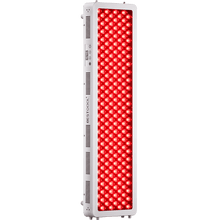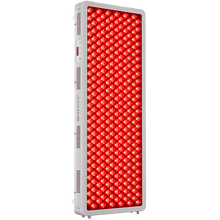Red light therapy has become an increasingly popular skin treatment over the last few years. Also known as photobiomodulation or low-level laser therapy, red light therapy exposes the skin to red and near-infrared wavelengths of light, which provide an array of benefits - from reducing inflammation and stimulating collagen production to improving the appearance of fine lines, wrinkles, and scars.
When using red light therapy for anti-aging, skin rejuvenation, and acne treatment, many wonder if they can also apply antioxidant serums like vitamin C to enhance the effects. In this article, we'll explore whether it is safe and effective to use vitamin C serum alongside red light therapy.

Why Do Vitamin C Serum and Red Light Therapy Work Well Together?
Applied topically, vitamin C serums provide a robust defense against facial skin aging in numerous ways. As an antioxidant, vitamin C intercepts the barrage of free radicals unleashed from UV exposure, environmental pollution, stress, and other factors that accelerate aging changes. By neutralizing these DNA-damaging free radicals, vitamin C shields skin cell mitochondria to preserve their youthful energy metabolism and function.
Simultaneously, the nutrient powers up collagen synthesis for a firmer skin texture. Vitamin C enables fibroblasts—dermal skin cells programming the structural proteins collagen and elastin—to ramp up the production of these skin scaffolding materials. Enhancing collagen production is key because our skin loses an average of 1% of its collagen reserve every year, from as young as age 20. Vitamin C essentially slows the depletion rate.
The antioxidant also brightens, evens out, and smooths skin tone by impeding excess melanin synthesis behind pigment spots and dullness. On top of bolstering collagen and elastin fibers, vitamin C strengthens the skin barrier and also retains vital hydration and moisture in the skin.
When used alongside red light devices, vitamin C absorption and antioxidant functioning are taken to new heights. The visible red and infrared wavelengths pierce through the skin surface and then become absorbed by skin cells. This influx of photon energy activates cell mitochondria and metabolism to encourage collagen and elastin, increasing fibroblast activity. ATP energy production surges to power this accelerated tissue remodeling.
Red light further switches on genes and growth factors like TGF-β, connected to enhanced collagen production. Additional skin-restructuring benefits arise from red light, reducing inflammatory enzymes and compounds linked to photoaging impairment of collagen and hyaluronic acid. By relieving inflammation and stimulating fibroblasts, red light synergizes with vitamin C serums to achieve faster and greater collagen regeneration over time.
In summary, the tandem stimulus of topical vitamin C antioxidant reparative effects and red light biostimulatory effects enables superior mitochondrial, collagen-boosting, and skin tone improvements unattainable through either modality alone.

Is it Safe to use Vitamin C Serum with Red light Therapy?
It is generally safe to use vitamin C serum in your red light therapy skin routine when following precautions. We do not recommend combining vitamin C serums with red light for those with:
- Known allergies or sensitivity to vitamin C (l-ascorbic acid).
- Severe acne is prone to irritation or post-inflammatory hyperpigmentation.
- Very sensitive skin is prone to redness and reactivity.
- Skin cancer lesions or a history of skin cancer.
How to Use Vitamin C Serum with Red Light Therapy?
Employing vitamin C serum in conjunction with red light therapy devices is reasonably straightforward for at-home use. However, following the optimal step-by-step routine allows you to gain the full anti-aging and complexion-enhancement potential from their synergistic effects.
- Initially, thoroughly cleanse the face as usual, taking care to remove all makeup, oil, and debris from the skin's surface. Gently pat away residual dampness rather than rubbing the face dry. Refrain from leaving any droplets of water on the complexion before red light application, as moisture can interfere with optimal photon penetration into the skin.
- Once the face is clean and slightly damp at most, apply a few drops of your preferred vitamin C serum evenly across the face, neck, and décolletage using your fingers or a dropper. Allow 5 to 10 minutes for complete serum absorption into the epidermis before proceeding. You'll know it has fully absorbed when your complexion feels smooth, non-tacky, and free of residue.
- Next, carry out your standard at-home red light therapy session while the vitamin C remains fresh on the complexion. Position yourself appropriately, facing the red light panel or device at distances specified in its user manual. Switch on the unit, selecting effective wavelengths and treatment times suited to your skin. Most devices suggest sessions of 10 to 15 minutes, three to five times per week, for visible skin-enhancing effects.
- After completing the full red light therapy session, do not rinse off the vitamin C serum – leave it in contact with the skin so the two modalities can continue working in synergy. Conclude the routine by gently applying your regular facial moisturizer, followed by SPF 30 (or higher) broad-spectrum sunscreen to protect the complexion before any sun exposure that day.
The Vitamin C and photon energy will team up to remodel aged cells long after the regimen is over, while their nutrients and stimuli remain bioavailable within the skin. Just remember that vitamin C may increase photosensitivity. So, religiously adhering to daily sun protection is vital when combining both skin-enhancing therapies for safety.

What Kind of Vitamin C Serum Should I Use with Red Light?
The gold standard vitamin C serums for red light therapy contain a stable form of l-ascorbic acid (pure vitamin C) at an effective 10% to 20% concentration. This concentration range ensures maximum antioxidant protection, boosts collagen production, and helps even out skin tone, all enhanced by the RLT device.
Scan the serum's ingredients list to confirm the form of vitamin C included. Opaque, clear, or yellowing formulas signify oxidation and degradation of the vitamin, rendering it ineffective. Instead, seek out serums bottled in UV-protectant darkened glass, preventing light exposure.
Certain vitamin C serums also integrate complementary antioxidants like vitamin E and ferulic acid, which reinforce its stability for longer-lasting facial rejuvenation effects. These supporting nutrients further shield against sun damage, inhibit pigmentation, and promote healthy collagen growth when applied with red light.
Additionally, the ideal vitamin C serum texture feels lightweight, smooth, and easily absorbable. Formulas infused with hyaluronic acid, ceramides, and plant oils ensure adequate hydration while the lipids and emollients lock in moisture and allow deeper vitamin C penetration.
Before committing to consistent use, first patch test any new vitamin C serum on your neck or behind the ears for a week, watching for signs of skin irritation, redness, or undesirable reactions. Promptly discontinue use if sensitivity occurs.
Overall, an appropriately formulated, high-quality vitamin C + antioxidant serum bolsters the anti-aging results possible from at-home red light therapy. Just be sure to assess tolerance and monitor your skin's responses with continued use.
The Bottom Line
Applying vitamin C serum with red light therapy is not only safe for most complexions but significantly amplifies their individual skin rejuvenation benefits. By targeting oxidative damage, upregulating collagen production, and improving dermal skin cell metabolism in tandem, youthful facial skin texture with even tone and reduced signs of aging can be sustained long-term with this synergistic pairing.
However, to avoid potential irritation and maximize skin-enhancing results, best practices should be followed - from selecting the right vitamin C serum formula for your skin needs to appropriate procedures when applying alongside red light therapy.














 Small
Small

 Moderate
Moderate

 Moderate
Moderate

 Moderate
Moderate

 Full
Full



